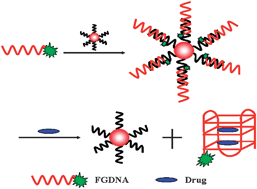The G-rich overhang of human telomere tends to form a G-quadruplex structure, and G-quadruplex formation can effectively inhibit telomerase activity in most cancer cells. Therefore, it is important to identify the formation and properties of the G-quadruplex, with the particular aim of selecting G-quadruplex-binding ligands that could potentially lead to the development of anticancer therapeutic agents. With this goal in mind, we report a fluorescence resonance energy transfer (FRET) assay system for the identification of G-quadruplex ligands using DNA-functionalized gold nanoparticles (DNA-GNPs) as the fluorescence quencher and a carboxyfluorescein (FAM)-tagged human telomeric sequence (F-GDNA) as the recognition probe. A thiolated complementary strand of human telomeric DNA (cDNA), which first adheres to the surface of the GNPs and then hybridizes with F-GDNA, results in the fluorescence quenching of F-GDNA by the GNPs. However, fluorescence is restored when single-stranded F-GDNA folds into a G-quadruplex structure upon the binding of quadruplex ligands, leading to the release of F-GDNA from the surface of the GNPs. Combined data from fluorescence measurements and CD spectroscopy indicated that ligands selected by this FRET method could induce GDNA to form a G-quadruplex. Therefore, this FRET G-quadruplex assay is a simple and effective approach to identify quadruplex-binding ligands, and, as such, it promises to provide a solid foundation for the development of novel anticancer therapeutic agents.

You have access to this article
 Please wait while we load your content...
Something went wrong. Try again?
Please wait while we load your content...
Something went wrong. Try again?


 Please wait while we load your content...
Please wait while we load your content...